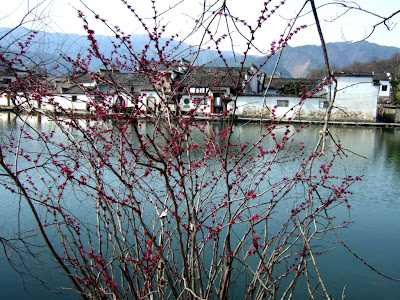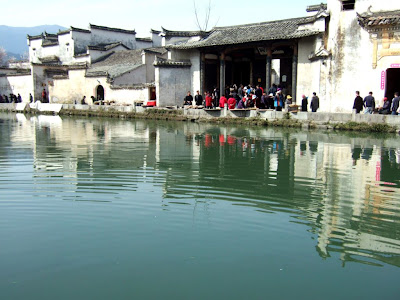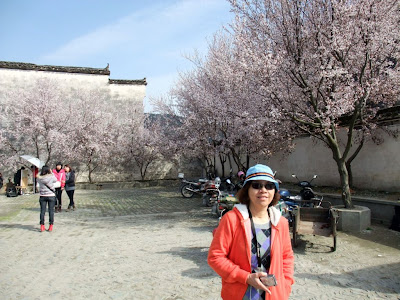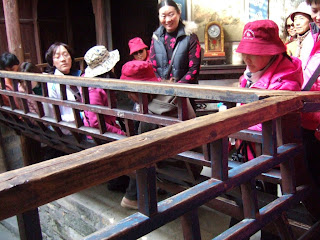

Hongcun and Xidi, located at Yixian were the most representatives local style residences in South Anhui Province. The settlements were established 900 years ago, in Song Dynasty and flourished during Ming and Qing Dynasties when they became trade center of the region. Most of the buildings from that period still exist in the village today. In year 2000, UNESCO listed them in The World Heritage Site. Hongcun lies 10 km north east of Yixian County and about 85km away from Tunxi, at a high altitude and shrouded by clouds and mists. Though it is not included in most travelers' itinerary, Hongcun enjoys the reputation of a village in beautiful Chinese picture. It appeared as several back grounds in the famous film of Crouching Tiger, Hidden Dragon.



The view from entrance gate where an admission fee at Rmb110 for an adult and RM55.00 for seniors, was collected.


Hongcun resembles a sleeping cow nestling among the hill and surrounded by green farms.


A serene and pleasant place for unhurried days. A truly beautiful part of rural China.


South Lake is an artificial lake built during Ming Dynasty wrapping itself up in the shape of an archers bow around the front part of the village.


Hongcun was built in a shape of an ox with Leigan Hill as the head, two trees as horns, houses as body, winding stream as intestines, pond as stomach and 4 bridges as its legs.


During ancient days, Hongcun was the only access to Beijing from Yixian to do business.


South Lake is an artificial lake built during Ming Dynasty wrapping itself up in the shape of an archers bow around the front part of the village.


Every day, there were group of artists positioned at South Lake embankment, capturing and illustrating the beautiful landscape of this ancient settlements in their painting.









The stone bridge at South Lake is a great spot to capture the beautiful view of village and hill reflecting in the lake water.


The stone bridge crossing South Lake offers an elegant entry to the village.






Many typical Anhui buildings dating back to Ming and Qing Dynasties are regarded as the best examples of style architecture.



Hongcun village actually is quite small but it is flat, covering a land area of about 28 hectares only.


Interesting and beautiful sights along the maze like lanes when you randomly walk around the village.


No one will ever lost in this village as all roads inevitably lead back to Central and south Lake.




Vegetables are air dried and preserved as an ingredients to almost all dishes they cooked.


Air dried "xuechai" is part of the daily life to all residents as it is their food specialty. But to outsiders, it becomes an agent to the scenery, attracting many's attention.


 >
>The Crescent Pond or Yuezhao in Chinese located at the center of Hongcun Village, was the base for Chinese special commemorative stamp in year 2006. The pond appears as even as a mirror and water keeps clean all year round.


The pond was built by Wang Siqi, the 76th generation of village ancestor in Yongle period (1403-1423) during Ming Dynasty. Water flowed into the pond from the mountain following a man made system channel for people to use it for prevention of fire, drinking and also washing.


Descendant of Wang family later expanded it into the crescent shape. The village is crisscrossed by a complex network of water canal feeding into the Crescent Pond.



Hongcun's myriad of short narrow cobblestone paved lanes make walking the easiest and the only way to get around the village. All roads lead to Moon Pond and South Lake.



The narrow cobblestone paved lanes winding around the village.




Some of the lanes were paved with black stone. Village's intestinal network of canals run past the front yard of each house, fed by water diverted from Jilin Stream, originated from a spring in the hillside behind village.


The boxy white washed buildings with pointed black tiled roof.


There are artist and art students every corner to illustrate the ancient form of 900 years old Chinese village.




The two peonies that had been grown for more than 100 years, still bloomed with flowers every year.


Several large residences reflect the wealth of its past residents in the ornate carvings on every beam and column like Chengzhi Hall, Jingxiu Hall, Dongxian and Xuren. It was fortunate that all buildings remain intact without much damages from the cultural revolution.



Hui's architecture is renowned for the exquisite carvings on stones, bricks and wood.


Chengzhi Hall ( 承志堂), the grandest and best preserved hall in Hongcun, was constructed in late Qing Dynasty by a wealthy salt merchant to accommodate his two wives. The entire hall has nine opened roofed yards with more than 60 rooms. Varieties of figures and patterns were carved on the columns, beams and door frames and some of wood structures were gilded with gold. The supporting beams of one room was constructed in the shape of Chinese character Luck ( 福 fu). It was praised by villagers as Folks Imperial Palace


The fascinating wood carvings and its opened roof yard which lets light and rain coming in while the stone floor below allowed the water to subside off.




Almost all wooden beams and wall panels are decorated with carvings of nature and Chinese mythology.





The adorned ceiling with carving butterflies and ornamental wood carvings doors are so lovely.


Those carvings on door frames, lattice walls, column, and beams in the halls displayed with poise and refinement birds, flowers, grass and figurines were vividly presented.




Ancestral Hall. Hongcun was the main village where Wang families live together. Wang clan, a respectable family in central plain of China is the earliest ancestor of Hungcun villagers, moved down from Jinlin to Huizhou during Han Dynasty.




Hongcun is a real village where people go about their daily lives with little concession to your presence. They have their pork, fish, vegetables or herbs hanged or placed in front of their house to preserve it instead of the tempting souvenir. Unlike many parts of tourist centers in China, there are very few souvenir stalls or pushy touts in the village.



"Xuechai", the preserved vegetable is their local specialty and they used for everything, tasty but too salty, instead the sesame crispy flat bread, ready in a portable drum oven from those elderly women, was very very nice.



The freely fat geese, the raw and preserved "xuechai" could be seen through out the village, near the pond or outside the residences.



Hongcun does not feel like given itself to tourism. It keeps its serene atmosphere, calm, quiet and low key.




Ancient lives in present world, cleaning vegetables at the upper stream and washing clothing at down stream. All jobs are done right in front of their door steps, open air.




Xidi Village is 18km away from Hongcun, constructed during Song Dynasty (960-1127). Like Hongcun, Xidi was also famed as being Ming and Qing local residences museum.. It has 124 ancient residences, 3 ancestral halls, pavilion, gardens, courtyard, some grand houses reserved for high ranking imperial officials and a beautiful archway.


Xidi was encircled by green hills with two streams flowing through the village from east to west, converging at Huiyuan Bridge.



There are only two main streets at Xidi but narrow lanes which were paved with cobbles and black stones are 99 of them .



The scenic surroundings of the two ancient villages.


Scenic rural sights.


Flowers fully blossom at peach farm along the way to Xidi and Hongcun villages.



Lovely peach flower.



Where they want to go, I do not know. People are just merrily walking on the road, in the fresh air, under clear traffic, heading for their destination, so relaxing.


Housing quarters were nested within hills and ranges and most of the residents are tea farmers.


Little villages nearby, at dusk


Huangshan region grow varieties of good tea and supplies one of the best tea in China. both sides of the road.






No comments:
Post a Comment